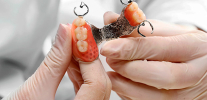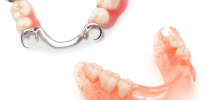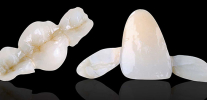
Although in its present form, the clasp prosthesis was first made in Germany at the beginning of the twentieth century, however, this type of prosthesis was, in fact, known from the time of the Egyptian pharaohs, in whose tombs found primitive artificial limbs with artificial teeth in the mouth of the mummy (they were attached with wire ). A simple idea, which is the basis of the clasp prosthetics, today has been further developed, which allows you to create high-tech prostheses, functionally and externally practically indistinguishable from natural human teeth.
Simplistically speaking, the squash prosthesis is a type of removable denture that transfers the load both to the remaining teeth and to the mucous tissues. (on the gum, and in the case of a prosthesis for the upper jaw - on the sky). The basis of any type of clasp prosthesis is the power frame in the form of an arc - in fact, a byugel (“bugel” is translated from German as “arc”). For this reason, the prosthesis itself is often referred to as arc.
Below the photo shows examples of cusp dentures:
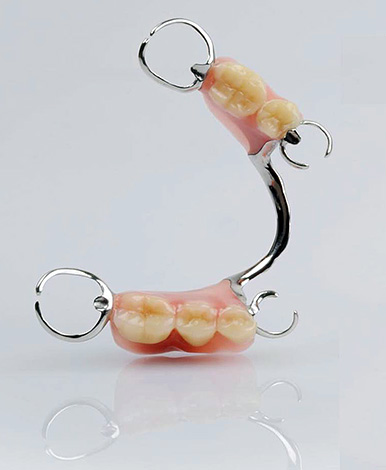
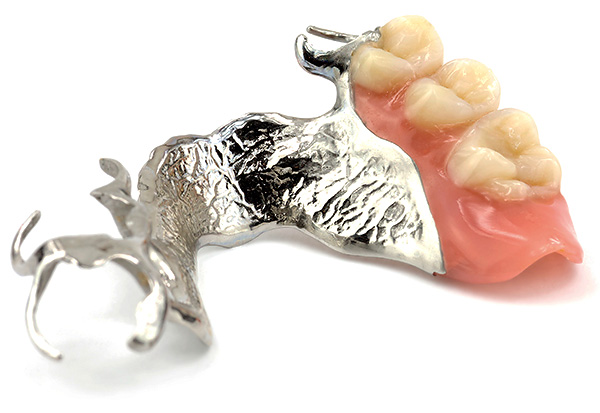
On a note
Clasp prosthetics allows you to eliminate partial defects of the dentition, while maintaining a high level of aesthetics and at the same time not seriously hitting the pocket - the cost of such a prosthesis is usually significantly lower than the cost of prosthetics on implants.
At the same time, one should not confuse the clasp prosthetics with the very “grandmother's” prostheses (“false jaws”), which they put in glasses every night and for which many patients are totally opposed. Byugel does not have a massive plastic base - the basis of covering the sky, and its absence provides many advantages over the so-called “suction prostheses”. In addition, the clasp prosthesis can be worn around the clock, removing only every few months for additional hygiene.
The advantages of the clasp prosthetics allow today to use this technology, including as a replacement for fixed prosthetics, especially when the teeth in the mouth can not withstand the chewing load from the "bridge". And despite a number of shortcomings (we’ll talk about them a little lower), the realities today are such that not only the elderly, but also young people use the bugel dentures in Russia.
Features of the clasp prosthetics and its varieties
The most important characteristic of a dental prosthesis is the reliability of its fastening in the oral cavity. You will agree that very few people would have liked the thought that the prosthesis could one day fall out of the mouth during a conversation or during a meal. Meanwhile, with removable laminar dentures, it is possible and such.
Unlike byugelny prostheses, lamellar fasteners in the oral cavity is largely due to the suction to the mucosa. Actually, therefore, such removable dentures are popularly called sometimes “suckers”.
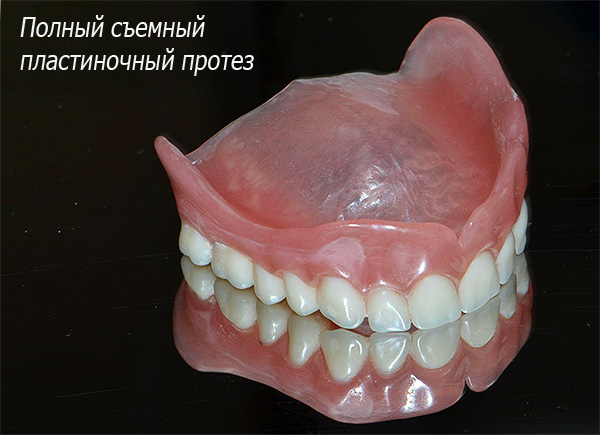
With the clasp prosthetics, much more reliable and durable fastening is realized. - for example, on special hooks or locks. All this ensures the immobility of the prosthesis during chewing food and, especially, the conversation.
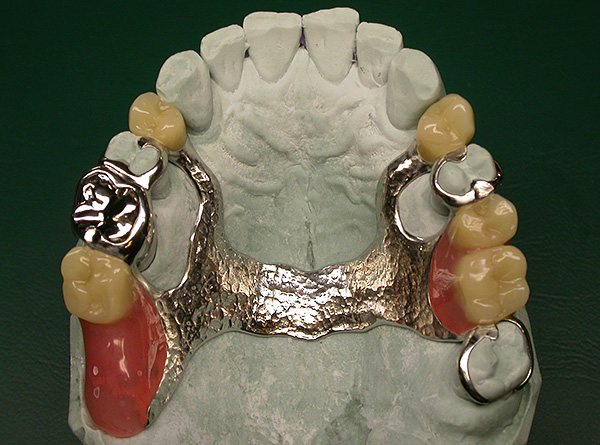
On a note
Many have probably heard that removable dentures during sneezing may even fly in the direction of the interlocutor. In this case, we are talking about acrylic plate prostheses. And this certainly does not apply to the clasp prostheses, which are adjusted so that they can be brought out of the oral cavity only along a certain trajectory, which excludes the option of unexpected prosthesis fallout.
How to fasten the "byulya" in the mouth without a plastic base?
Fastening dentary dentures is made using the existing teeth of the patient. At the same time, the following types of prosthetics are distinguished:
- On clasps (the prosthesis covers the abutment teeth with special hooks - clasps);
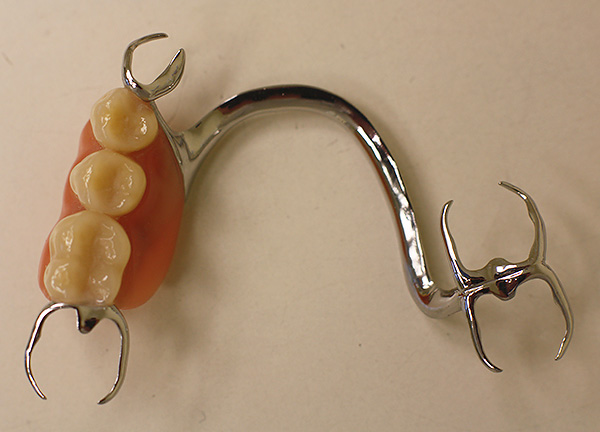
- On attachments (elements of small locks are installed in the abutment teeth and prosthesis, which are then snapped in);
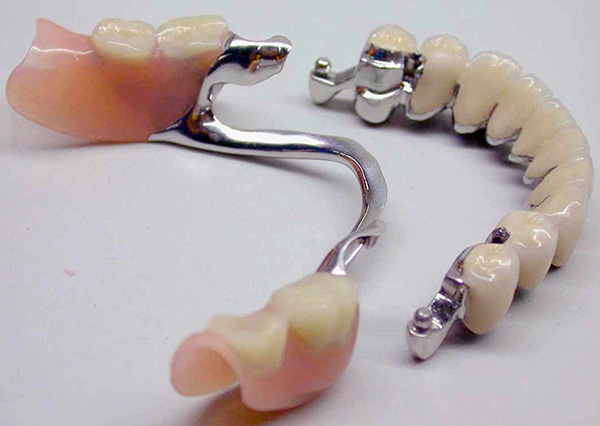
- On telescopic crowns (crowns are installed on the supporting teeth and in the denture - then the denture is simply put on the supporting crowns).
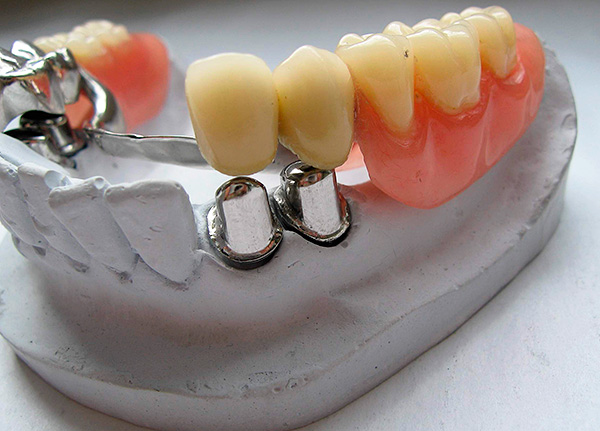
We will talk about the advantages and disadvantages of different types of fastening of the denture prostheses later on.
On a note
Meanwhile, it should be understood that if there are practically no teeth left in the mouth, then byugel prosthetics is unlikely to correct the situation - the prosthesis will simply not have anything to fix. In this case, an alternative option may be, for example, the use of a plate acrylic or nylon prosthesis (economy version), or prosthetics on implants using All-on-4 or All-on-6 technology (more expensive, but also much more convenient option) .
The main indication for installing a partial denture is the absence of several teeth in a row (usually 2-3) on one side of the jaw.However, everything is individual here: in a number of clinical cases, this prosthesis can be reliably installed with minimal “stock” of abutment teeth on each jaw.
That is, the possibility of using a partial denture system is largely determined by the current state of the patient’s oral cavity. In particular:
- The position of the teeth, their number and condition;
- The presence or absence of gum disease (periodontitis, periodontal disease);
- The nature of the bite;
- Maxillofacial anomalies.

It is interesting
In general, when planning prosthetics, it is important to take into account the many nuances, and the dentist must carefully examine the patient before promising something or, especially, to start something to do. Otherwise, it is possible not only to make an inconvenient and useless clasp denture, but in the coming months to disable even good supporting teeth, to form a pathological bite and abrasion of teeth, and in severe cases - to provoke serious deformations of the TMJ, to create problems with diction.
When choosing one or another version of the clasp prosthetics, one should not forget that the use of a dental prosthesis is aimed not only at regaining the lost chewing function, but also, and quite importantly, at restoring the natural beauty of a smile.And byugelny artificial limbs really allow to make it.
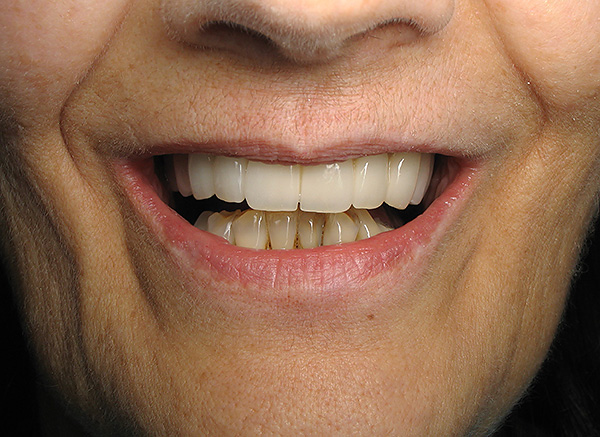
However, from the point of view of aesthetics, there are nuances that are largely determined by the method of fixing the prosthesis in the oral cavity — on clasps, attachments or telescopic crowns.
In which cases to prefer clasp prostheses with klammernoy fixation
Is it possible to talk about aesthetic perfection when it comes to cusp denture dentures?
After all, the klammer is a molded metal hook that clings near the neck of the abutment tooth directly near the gum edge. Simply put, this hook is clearly visible in the mouth.
The photo below shows a clasp-shaped denture prosthesis - a metal clasp can be seen even with the naked eye:
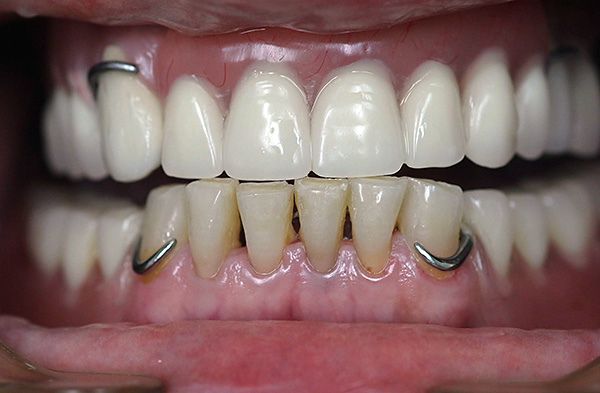
Despite the possibilities of the dental technician to partially mask these hooks, still the data of the blugel cannot argue in the aesthetics of the by-dent dentures with other types of fasteners.
Klammer fixation with a clasp prosthesis can be preferred if:
- There are severe restrictions on finance (other options are more expensive);
- It also requires a splinting effect due tothat the clasps are able to distribute the load in a special way during chewing - this makes it possible to save loose teeth in case of periodontal diseases (when using a splinting byugel prosthesis).
In order to enhance the aesthetics of the “hook” byugel, as well as to create maximum comfort during their operation, Quadrotti and Akri-Free prostheses were invented.
Quadrotti dental prostheses (Quattro Ti) are made of plastic, whose properties are almost identical to nylon - flexible and at the same time very durable. Hooks of such a prosthesis are not striking, but upon close examination, they can still be seen.
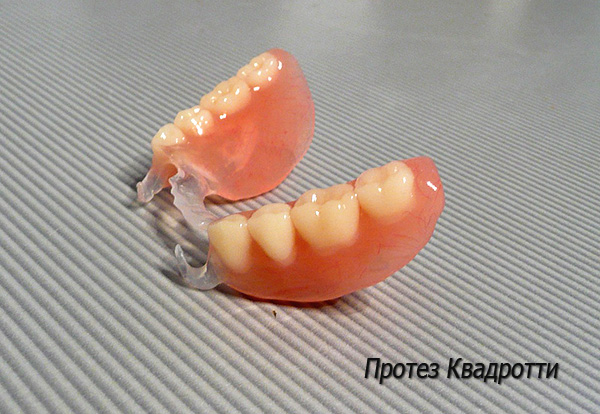
Acry-Free prostheses are made of acrylic resins - the base is less elastic than Quadrotti, but also quite strong. The prosthesis also keeps in the oral cavity due to the clamping fixation, and the hooks are less noticeable than the metal ones.
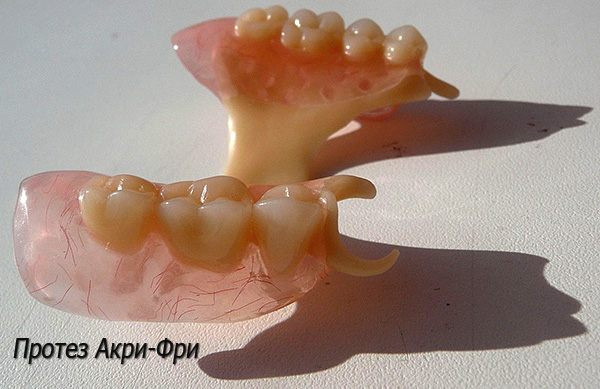
Quadrotti and Akri-Free dentures are quite expensive - on average more expensive than with a metal base based on titanium alloy.
Splinting properties of bügel (about the therapeutic effect of prosthetics)
Before proceeding to the consideration of the cusp prostheses on attachments, it is useful to say a few words about the splinting properties of the cusps.
Klammer fixation of the goggles, in spite of some aesthetic imperfections, remains popular, including due to the fact that it allows to save loose teeth from loss. Thus, the prosthesis makes it possible not only to restore the lost teeth, but also to strengthen the existing ones.
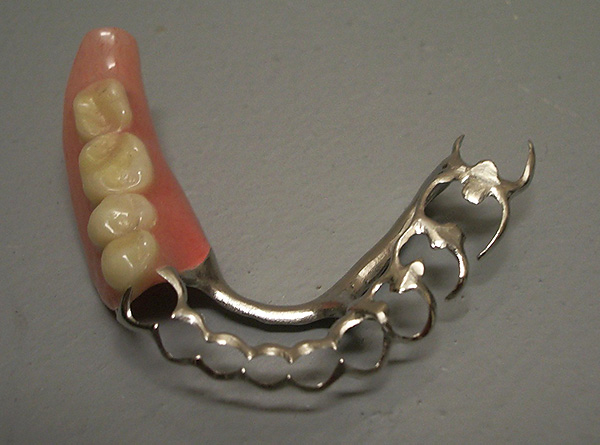
A splinting prosthesis consists of a metal arc adjacent to the inner side of the teeth, and the clasps have many links, claw-shaped processes or rings that fix each movable tooth. This prosthesis makes it possible to evenly distribute the chewing load from the mobile teeth to healthy ones, as well as to the alveolar processes (it is recommended to close the crown teeth with crowns).
The photo below shows the system of clasp splinting prosthesis:
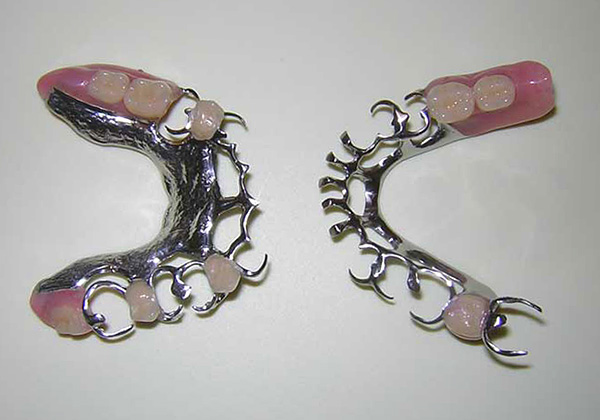
Splint prosthesis is indicated for:
- Naked roots;
- Periodontal disease (with bleeding, pathological periodontal pockets and tooth mobility);
- Improper position of teeth;
- When teeth are removed (after a tooth is removed, for a certain time, the adjacent teeth gradually begin to lean towards the defect,and antagonist teeth on the opposite jaw are pulled out from the hole, which may lead to their mobility).
Like other types of clasp prostheses, splinting structures have their own contraindications for installation:
- Gestation period;
- After radiation therapy;
- Oncology;
- Acute inflammatory processes in the mouth;
- Mental disorders;
- Serious diseases of the heart (blood vessels) and respiratory system in the period of exacerbation;
- Allergy to the material of the prosthesis;
- Bone diseases;
- Alcoholism (drug addiction);
- Lack of normal levels of oral hygiene;
- Severe atrophy of the alveolar process;
- Lack of necessary abutment teeth or their insufficient height;
- Severe bite pathology.
These contraindications are relevant for all types of bugel dentures.
Clasp prostheses with locks (attachments)
"Attachment" in translation from English means "connection". Attachments (attachments) are a system of locking fasteners that allow you to securely fasten a partial denture in the mouth with minimal damage in terms of aesthetics.
Special crowns, which have a lock (attachment), are usually put on the abutment teeth, and the other attachment is hidden inside the prosthesis.With this type of attachment, part of the load during chewing food is transmitted through the lock to the supporting teeth.
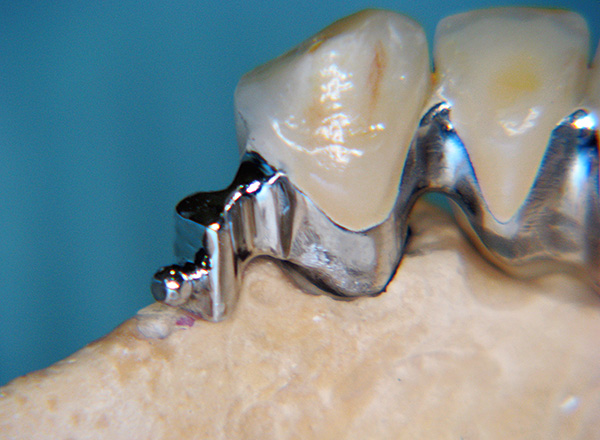
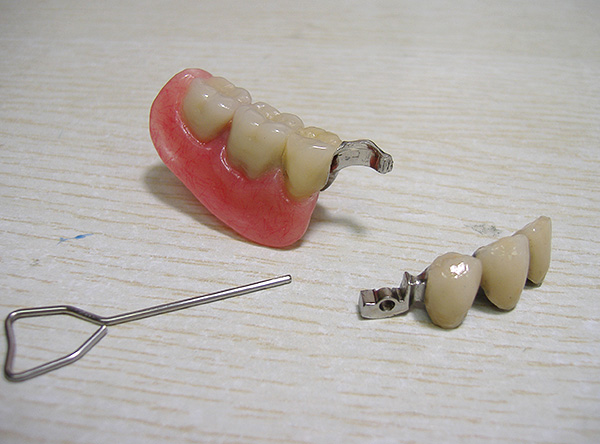
In contrast to the clamp fixing, locking by-denture prostheses have a number of significant advantages:
- Higher aesthetics due to micro-locks hidden in teeth and byugel. From the side it will be almost impossible to understand that a person has a prosthesis;
- Maximum fit accuracy;
- Longer service life (7-10 years);
- Ease of operation;
- Increased stiffness of fixation;
- Shorter habituation period.
Disadvantages of clasp prosthetics on attachments:
- Higher cost in comparison with classical clasps with clamp fixing;
- The need to almost always de-pulp (remove the "nerve") in the abutment teeth in connection with the preparation of the castle attachment.
There is also a general lack of clasp prostheses - gradual atrophy of the bone tissue under the prosthesis, in connection with which occasionally it is necessary to stop the voids by applying a layer of plastic on the byugel.
Fastening a partial denture on telescopic crowns
One of the most difficult to manufacture is the so-called telescopic byugel (it is fixed at the expense of telescopic crowns). He is also the most aesthetic in its class.
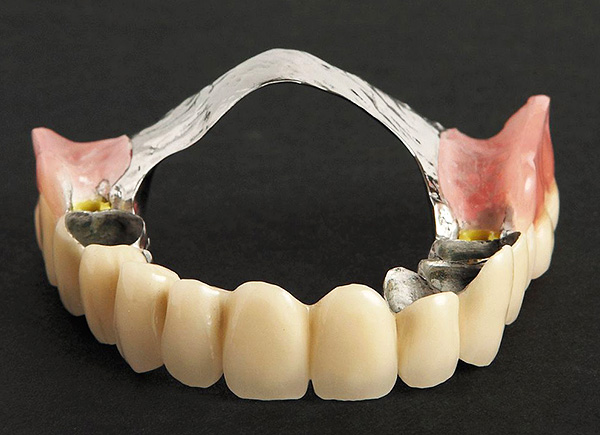
Before installing the prosthesis, the orthopedist grinds (prepares) the abutment teeth under the crown, covers them with a metal crown, and only then - places the byugel, on which the crowns are also fixed. Simply put, the prosthesis consists of two parts - removable and non-removable, and when the prosthesis is placed on the crown on the abutment teeth, they enter the crowns of the removable part.
The essence of the mount is shown in the photo below:
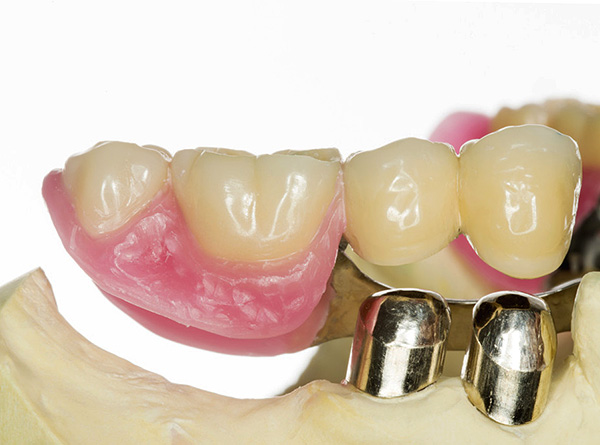
The crowns on the abutment teeth are cemented firmly, they cannot be removed so easily, but the prosthesis can be removed. For reliable fixation it is ideal to use at least 6 telescopic crowns.
Despite the simplicity of the idea, this type of clasp prosthesis is distinguished by high complexity of manufacture (and, as a consequence, by a high price). In Russia, this type of prosthesis is not as popular today as in some countries of Western Europe and the USA.
Advantages and disadvantages of clasp prosthetics on implants
All the above options for clasp prosthetics have two major drawbacks:
- All of them suggest the presence in the oral cavity removable design. In other words, the denture will have to be regularly removed from the mouth - at least in order to carry out its hygiene (clean with toothpaste).In many patients, this is somehow associated with the “false jaw”, even if the prosthesis replaces only a few lost teeth and will have to be removed only once every 2-3 months;
- Some patients don’t even know about the second drawback of the clasp prostheses, and of course, this will hardly be mentioned in the promotional materials of the clinics. But the fact is that even the most beautiful and well-fitted byugel prosthesis does not prevent the gradual atrophy of the bone tissue of the alveolar processes. As a result, over time, the jaw bone will atrophy, as it does not receive a full-fledged chewing load, previously transmitted through the tooth root. The loss of bone then leads to a change in facial features characteristic of older age.
Actually, fixing a clasp prosthesis on implants allows to get rid of these disadvantages to a certain extent.
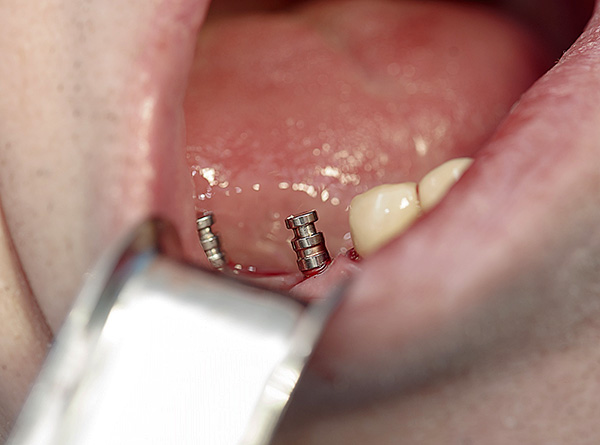
In general, there are a lot of advantages:
- Bugel on implants is a conditionally removable prosthesis (that is, it does not need to be regularly removed by yourself, and it can only be removed by a doctor using special tools);
- Atrophy of the jaw bone is prevented directly in the area of the installed implants, since the implant performs the function of an artificial tooth root.However, it is clear that if only 1-2 implants were installed during prosthetics, the effect as a whole will be small;
- In the case of a prosthesis on the upper jaw, no support is required on the sky - this greatly facilitates the addiction to the prosthesis (discomfort and gag reflex do not occur, diction is not disturbed);
- When attaching a prosthesis to implants, the presence of several strong teeth in a patient becomes unimportant (such teeth in other versions of prosthetics would become supporting).
Clasp prosthetics on implants can significantly save compared to multiple implantation, when an implant plus a crown would have to be put in place of each lost tooth. Often, only the end teeth (extreme chewing) are missing for the attachment of the partial denture - in this case, the installation of the implant will be almost the only way to solve the problem.
The most popular variant of dental prosthetics today with their complete absence is the All-on-4 and All-on-6 technologies, which imply the use of byugel prostheses with a beam design with installation on 4 or 6 implants, respectively.
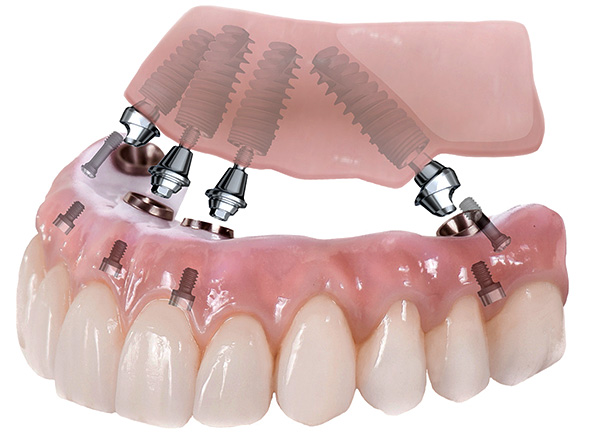
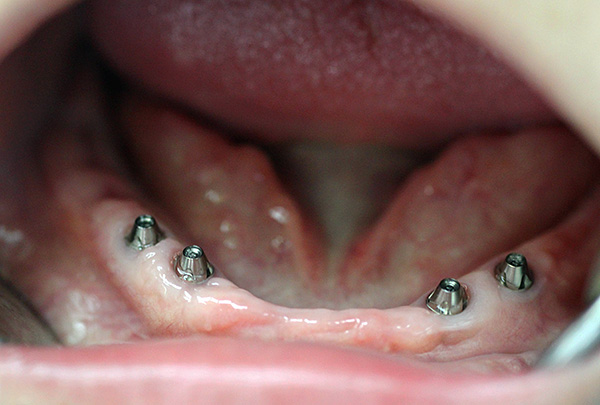
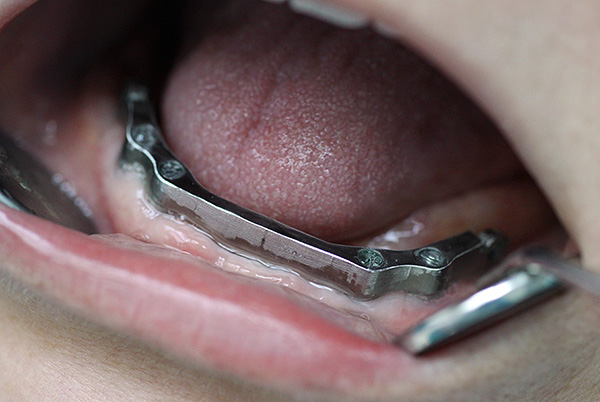

For the sake of fairness, it must be said that this type of prosthetics refers to the byugeln only formally - usually, byugelny prostheses are understood as constructions that are mounted in the oral cavity using the above-mentioned clamps, attachments or telescopic crowns.
Feedback:
“I am a lonely military pensioner, I am 70 years old. About 8 years ago, all the teeth flew. Three times I inserted suckers in a departmental military polyclinic for a special pull, but they held on during the conversation, and devils fell during the meal, and nothing could be done. The dentist explained to me that they say that you have fleshy cheeks there, irregular strands, a mouth curved and everything like that. For the third time after one Armenian I ran away with the last falling prosthesis and came to visit my son in Peter. He advised me to the clasp prosthesis on implants. I was put in the clinic 4 of these bolts, and they prosthesis. It turned out to be a little expensive, although for the action, thanks to my son, he threw some money. But it's definitely worth it, chewing has become normal. Now I have to marry again ... ".
Sergey, Moscow
General principles for the manufacture of partial denture
The cusp prosthesis, compared with a full and partial laminar prosthesis, is significantly more complex in its manufacture. It is possible to distinguish the following stages of manufacturing structures:
- Clinical (in the chair of an orthopedic surgeon);
- Laboratory (in the dental laboratory).
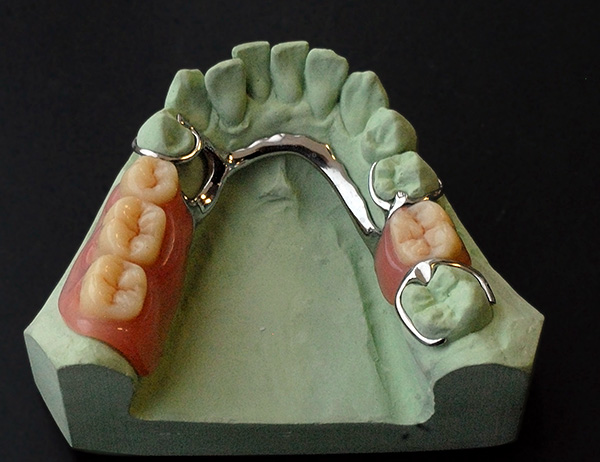
Before the start of treatment, the most important thing is to take an anamnesis (survey) and comprehensively examine the patient with a plan for the forthcoming treatment. It turns out important details, ranging from the patient's allergic status and characteristics of the bite to the definition of prosthetic tactics and the choice of the prosthesis itself.
If the choice for objective reasons tends to byugelny prosthetics, the orthopedic surgeon chooses supporting teeth. If they require treatment (filling or depulping), then the dentist-therapist is engaged in preparing the teeth for prosthetics. Further, the orthopedic surgeon conducts preparation of the prepared abutment teeth under the crowns (this is especially true for castle and telescopic types of fastening).
On a note
The choice of abutment teeth is a very crucial moment, since their further fate may depend on it.With the wrong choice of abutment teeth, they can loosen from loads.
After removing the impressions from each jaw (two impressions), they are sent to the dental technicians, and the laboratory stage begins: making a model of the prosthesis using the impression.
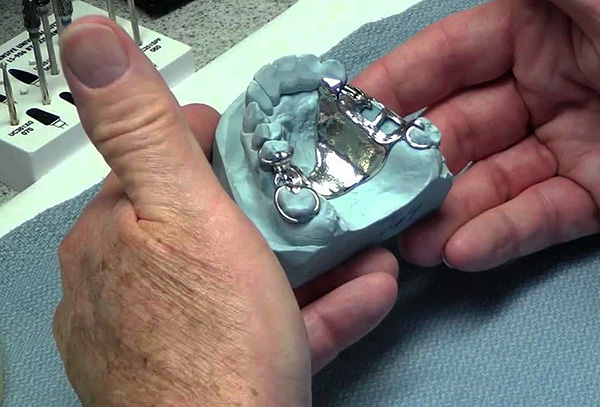
After that, the prosthesis is tried on in the oral cavity of the patient and corrected. Then the construction is sent back to the laboratory, where the final stages of completion take place, after which the orthopedic surgeon fixes it in the oral cavity and explains to the patient the features of the insertion and removal of the partial denture, as well as the rules for caring for it.
The completion dates of the partial denture are individual, and are largely determined by the type of prosthesis chosen. Dentures on clamps can usually be installed within 2 weeks, and dentures with locks or telescopic crowns can be installed within 3–4 weeks.
How much is today making a clasp prosthesis?
The cost of the clasp prosthetics depends on many factors, but there are two main factors: the complexity of manufacturing the prosthesis and the price of the materials used. For example, byugel dentures on telescopic crowns, which are a high-precision construction, will be relatively expensive.Byugel prosthetics on implants would be even more expensive, when in addition to the prosthesis manufacture, the surgical stage is also assumed.
Often precious metals (gold, platinum) are used in clasp prosthetics, so these products will cost more than dentures made from “classic” titanium-based alloys.
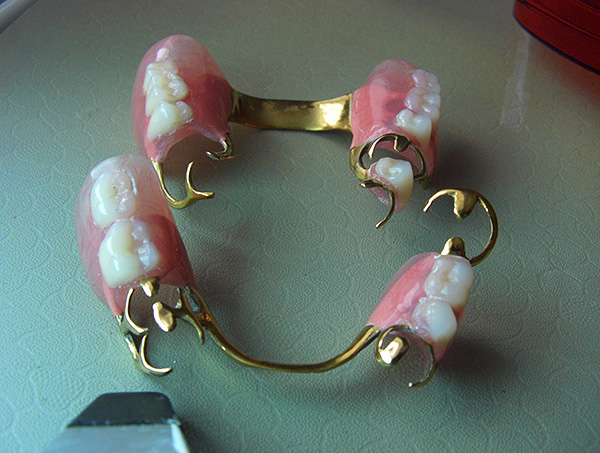
Byugel with clasps, which can be purchased at a price of about 30-40 thousand rubles per prosthesis, are considered the most "budget". Byugelnye systems on attachments (with fastening on two micro locks of the system “Bredent”, Germany) cost approximately 80-100 thousand and more for the finished product. The cost may vary, depending on the region, and in Moscow prices are usually much higher.
As for the cost of clasp prosthetics on implants - here it should be borne in mind that the installation of a single implant will cost an average of 50-80 thousand rubles. You may need to install several implants, plus you need to add the cost of the prosthesis.
On a note
Generally speaking, the cheapness of some dentures in comparison with others is very arbitrary. Of course, removable acrylic plate prostheses are almost always much cheaper than any byugel, but to compare the cost of the clasp dentures, relying only on the type of fastening - the approach is not entirely correct. Take, for example, at least clutch prostheses on clasps: they can be more expensive than on attachments, due to the use of precious alloys.
Again, clasp prosthetics on implants can be very “heavy” in price if premium implants are chosen (Straumann, Nobel), while in the case of using budget implants (Alpha BIO, MIS) the cost of “turnkey” work can come closer to the cost of installing a prosthesis on telescopic crowns using precious alloys.
How to care for a prosthesis to use it as long as possible
Unlike the same plate prostheses, a byugel does not need to be removed at night and stored in a “cup”. It is worn around the clock, but at first it is removed 2-3 times a day to carry out hygienic measures with the help of toothpaste and a brush. Do not take a toothpaste with a whitening effect (highly abrasive) because of possible damage to the surface of the prosthesis with abrasive particles.
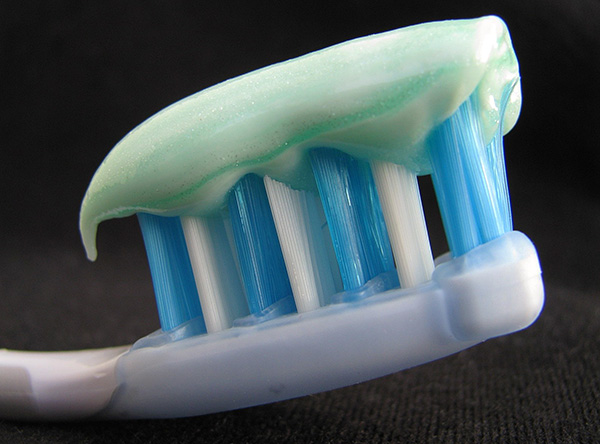
3-4 months after the installation, the byugel in the oral cavity is adapted so that its plastic edge sinks into the gum and food does not fall under it.This allows much less often to remove the prosthesis for hygiene, conducting it on the same principle as that of native teeth. However, once every 3 months it is desirable to remove the structure and place it in a special bactericidal solution for the treatment of prostheses (for 2-3 hours - to disinfect from pathogenic microflora).
Careful hygiene is also obligatory, not only for the abutment teeth, but also for all teeth existing in the oral cavity, with and without crowns. It is recommended to use a dental irrigator.
Once every six months or a year (depending on the clinic policy), the patient must come to the attending physician in order to:
- Check the dentition for the presence of super-contacts, that is, points where the bite on the artificial teeth of the prosthesis (and its existing ones) is clearly overestimated, which means there will be an overload of the tooth (s) and gradual destruction;
- To diagnose compliance with the basis of the byugel and gums, on which it relies;
- For professional dental hygiene.
If by the case of a number of objective reasons it is necessary to remove the clasp prosthesis for a long time, then its storage conditions should be as follows: in a dry, clean form in a plastic box at room temperature.It is prohibited to store the byugel in the refrigerator, or near the heating device due to possible deformation of the structure.
If you have personal experience of denture prosthetics - be sure to share the information by leaving your review at the bottom of this page (in the comments box).
Visual information about different types of prostheses
Useful video: byugel dentures as an alternative to implants

